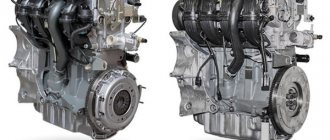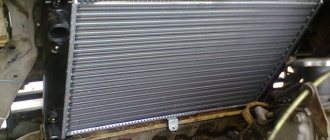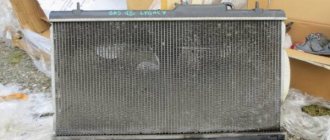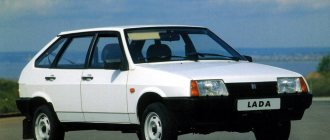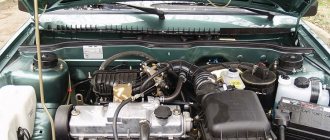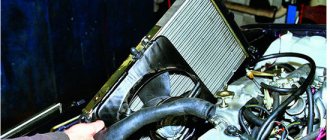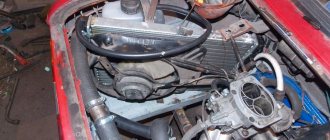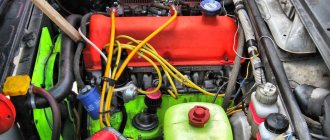They began installing injectors on VAZ 2109 engines after 2000; before that, the power system was exclusively carburetor. Some modifications of fuel injection systems had electronic controls that regulated the air supply. If the task is to modernize your car, then switching from a carburetor to an injector is a reasonable decision. But first, weigh all the positive and negative qualities of the remodel.
VAZ-2109 injector
There are rumors on the Internet that the VAZ 2109 injector has long ceased to be popular among car owners.
Anyone who wants to exchange a domestic car for a foreign car is mistaken. For the same money they will buy a beautiful firebird, under whose plumage there will be a decrepit, senile body, like that of a courier during the Kaiser’s reign. Yes, the VAZ has its drawbacks, but it also has quite a few advantages: if you buy even a used car from one owner and with low mileage, then the engine will almost always please you, the electronics will not seem stupid, so you can close your eyes to the rest .
Just don’t wave your hands now and say that domestic g... doesn’t sink in water. The interior is not a gift, but its explosiveness is fully justified by the material from which the body is made. This is not a piece of plastic covered with foil. Perhaps tuning the interior will help you.
The car is not wasted on trifles: if the problem is in the pads, then it will remain there. It happens that the panel goes out right on the road, but the problem is quickly eliminated, the stove fails, but you can find an approach to it with skillful tuning. There is a desire to change it to a more advanced tenth model - the problem will quickly be solved. You can sell a 2109 injector quite quickly, whereas a foreign car takes months to wait for a buyer.
And no need to say that you ride on the toilet. Even a Volkswagen with 25 years of life would not allow itself to be called that. And you! Oh, I wish I could take our nine-wheeler for a ride to Moscow! After that, you can erect a monument to her and become a pedestrian, and hang a photo with your iron friend in a frame on the wall.
It’s not for nothing that they say that the VAZ is a cheap car. For citizens of Russia and post-Soviet countries there will be no problems with spare parts for a long time. Do you want to do the renovation yourself? There is a lot of information in stores and on the Internet. Try to dig up so much material for a Korean car. You would rather love the domestic auto industry than a prince from far away, rusting right under your windows.
He doesn’t want to, my dear, it starts, there are no spare parts in the workshops, you have to wait for months until they bring it. But for our cars there is always a green light. Chairs in the evening – money in the morning! The VAZ is not as bad as it might seem at first, although it requires some fine-tuning. Do you still want to try a foreign car in action? Then buy at least an unfucked version, at least ride for pleasure until breakdowns lead to a nervous breakdown.
Car history
Towards the end of the 1980s, AVTOVAZ decided to fill the empty niche of comfortable and versatile family models with the VAZ-2109 car. The fact that the debut domestic mass-produced front-wheel drive car appeared at the Volga Automobile Plant was a significant event not only for the Volga residents, but also for the entire Soviet automobile industry.
It’s a little symbolic, but the start of production of the G8 coincided with a significant event that was celebrated in the fall of 1984 - the 60th anniversary of the automobile industry of the Union of Soviet Socialist Republics. After two years, the original assembly line of the car plant in Togliatti produced a pilot batch of 159 Nine models.
The new version of the “chisel” inherited all the technical innovations from the older model and was able to instantly gain the respect of car lovers. Among all the points, the most important was the “rational” number of doors. However, despite this, a three-door version entered mass production. The logical question arises, why?
Because in a state where personal transport was considered a luxury, and happy car owners felt the transport difficulties of their relatives and friends, the standard 3-volume sedan version was more suitable to the needs of drivers. For a long time, all Soviet mass-produced cars were produced in just such a body.
More productive station wagons, which were produced in small quantities, began to be sold only towards the end of the 1960s, and they were considered in great short supply. There was not a word about other versions of the body: directors of automobile enterprises did not even risk conducting experiments, objectively believing that these programs would not be positively received “at the top.”
But in the case of the G8, everything turned out in the opposite order. At the end of the 1970s, all of Europe was literally overwhelmed by the fashion for hatchbacks. The leaders of the Tolyatti automobile plant, wanting to comply with modern trends, during the design of the new model series, decided to introduce into it, in addition to the standard sedan, 3- and 5-door hatchbacks that were fundamentally fresh for Soviet industrial turnover.
The entry into the foreign market of a new car, designed in accordance with the standards of global trends, was supposed to strengthen VAZ's export positions. The Ministry of Automotive Industry cooled down the ardor of the engineers from Tolyatti a little, calculating the impossibility of financing the production of all 3 versions for assembly line assembly.
In reality, it was possible to free only one line of the factory conveyor for the assembly of 2 standardized modifications. As it turned out, the role of those “lucky ones” was a hatchback, which had a lot of common body elements. As the base version, they decided to choose a cheaper three-door car, and a couple of years later, a five-door car “came to the rescue.”
The sedan version (VAZ-21099) was introduced into mass production only at the end of 1990. Although this delay in a sense benefited the enterprise itself, since with the appearance of the sedan there would have been intense competition with the hatchback version, which was in no way included in the plans of the management of the Volzhsky Automobile Plant.
VAZ 2109 engine injector: control system diagnostics
Before touching upon general issues of diagnosing the control system, it is worth getting acquainted with the controller lamp
If a malfunction occurs while driving the car, the controller will detect it and notify the driver using “CHECK ENGINE”, while storing in its memory the necessary codes about the nature of the malfunction. With their help, the process of diagnosis and subsequent repair of the fuel injection system will be facilitated. It is the controller that is able to coordinate the operation of VAZ sensors and systems that are part of the general composition of all fuel injection units.
A few words about the DST-2M digital tester.
It is used to diagnose the engine injection control system. It is worth remembering that only a competent specialist can make the correct diagnosis. No matter how much an inexperienced mechanic strives to automate the process of diagnosing a car, having the necessary tools, he will not succeed without certain skills, which can in some cases aggravate an already difficult situation.
Diagnostics includes the following steps:
- checking the fuel supply system, the operability of all sensors, actuators and the ignition system;
- reading fault codes;
- compression measurement;
- data monitoring of the entire control system.
Once the injector has been diagnosed, the entire range of necessary services becomes clear if it is associated with a failed electronic system responsible for the performance of the engine.
VAZ 2109 injector controller
The controller receives the necessary information from the sensors, then makes calculations: based on them, it independently issues commands to the actuators. This device is quite reliable. One problem: it is afraid of large surges in on-board voltage. This can happen when the generator malfunctions or the starter sticks while the engine is running; sometimes the process of “lighting” another car or the use of a low-quality starting charger is to blame.
As soon as malfunctions occur, the controller immediately detects them, notifies the driver with the above-mentioned lamp, and stores the codes. Under his control, the injectors try to work smoothly, as does the ignition system.
The injectors turn on in pairs, but this depends on the type of controller itself. An interesting fact is that pairs of injectors tend to turn on alternately, approximately 180° from the crankshaft rotation. This is called double synchronous injection, but sequential operation is possible. An idle spark is provided for the system: 16-valve engines are an exception. They are already equipped with personal ignition coils for each spark plug.
This process occurs as follows: high-voltage pulses are applied to a specific pair, and the formation of a working spark occurs in the cylinder on the compression stroke and on the exhaust stroke. Otherwise, an idle spark will form. In this case, a small amount of energy is required for the cylinder during the exhaust stroke, and the rest of it is used during the compression stroke. This is how the process of ensuring normal sparking and unhindered ignition of the fuel mixture occurs. The whole process can be repeated if the cylinders decide to switch roles unexpectedly.
The controller controls not only the fuel supply, but also the energy accumulation time and ignition timing. This concerns the crankshaft rotation speed in idle mode, the uninterrupted operation of the electric fuel pump, the tachometer and the warning lamp, which is located on the VAZ instrument panel, the cooling system, and the cabin air conditioning compressor clutch. The device generates certain speed signals to the trip computer, regulates fuel consumption, and maintains the required stereochemical ratio (gasoline-air as 1:14.7).
VAZ 2109 injector does not start
Problem: the car worked fine all day and drove dozens of kilometers around the city. I stood in the garage resting for several hours. The owner decided to go out again on business, but could not start it. It seemed like something was catching, but then it died out. I had to unscrew the candles, which were thoroughly wet, and put the ones I had just bought in their place. And again a bummer! I had to check the timing belt: it turned out to be normal, I removed the battery and examined it for a failure. I checked the fuel pump: it is also ok. There is a return line, there is fuel too, but the car just doesn’t want to start.
Tips: heat the spark plugs, screw them in hot, try to start them. If the result is negative, then we can assume that the fuel was filled with low-quality gasoline; blow out the engine with the module turned off, and add a little oil to the cylinders; carefully inspect the wire near the sensor: it often breaks in this place. The terminal area is a vulnerable spot. Try to touch it, a spark should jump out.
Sensors VAZ 2109 injector
The VAZ 2109 injection system includes a certain set of sensors that collect information about the state and mode in which the engine is operating. Let's get to know them.
Mass air flow sensor - mass air flow sensor
It is installed on the air filter housing. Measures the amount of air sucked in by the engine from outside. Parameters – kg/hour. This device is considered reliable, but has an enemy - moisture, which is sucked in along with the air. A violation of its operation is indicated by inflated readings at low speeds, by approximately 15 - 25%.
Such actions lead to fluctuations in engine operation only at idle. But a stop is also possible after triple power modes or problems with starting. But underestimated readings lead to complete “dullness” of the engine or increased fuel consumption. If by default air consumption at idle should be within 10 kg/hour, then at 3000 rpm in 1 minute no more than 32 kg/hour.
Throttle position sensor
This device is installed on the side, on the throttle pipe, approximately on the same axis with the drive. Its job is to read the gas pedal. The main enemies of this sensor are considered to be engine washers, as suppliers of unnecessary moisture. The service life becomes unpredictable when exposed to water. Violations appear when roars and dips begin at idle, even under light loads.
Coolant temperature sensor
Located between the thermostat and the block head, it has 2 contacts. Do not confuse it with the single-pin temperature sensor located next door. The main function is to determine the engine temperature: the colder it is, the richer the fuel mixture.
Such a device is also called a thermistor or resistor, the change in resistance of which depends on many factors. Coolant temperature affects engine control characteristics. Despite the fact that such a device is reliable, it sometimes suffers from a number of malfunctions: a breakdown in the electrical contact inside the sensor itself, a breakdown of the insulation, or a break in the wire next to it or the throttle cable.
Coolant temperature sensor failure - If the fan is turned on when the engine is cold, the device may fail. In this case, you will experience difficulties when you need to start a warm engine or fuel consumption will be slightly higher than planned.
Knock sensor
Placed on the engine block, directly between cylinders 2 and 3. Manufacturers offer a choice of 2 sensor options – broadband (tablet) or resonant (barrel). Reliable, but requires constant cleaning of the connector.
The operating principle is similar to piezo ignition: stronger impact - greater voltage. His job is to track detonation knocks in the engine. Failure or possible breakage of the device manifests itself in the fact that the engine is “stupid” and fuel consumption exceeds reasonable limits.
Oxygen sensor
Manufacturers found a place for it on the exhaust pipe of the muffler. This is a serious, very reliable electrochemical device that can determine the presence of oxygen residues in exhaust gases.
The principle is simple: if oxygen is present, then the fuel mixture is lean, the oxygen mixture in the “No” mode is rich. Based on the sensor readings, they judge what adjustments should be made to the fuel supply.
It is strictly forbidden to use leaded gasoline. If the oxygen device fails, then expect high fuel consumption with a simultaneous increase in harmful emissions into the atmosphere.
Speed sensor
Designed for pulse formation, when the number of pulses should not exceed the limit allocated for the speed limit of the car per unit of time. Installed on top of the gearbox. These six-pulse speed sensors inform the controller about the current vehicle speed at a certain moment.
Reliability is average due to constant oxidation of the connector or wires. Failure usually results in a slight deterioration in driving performance.
Crankshaft position sensor
It is required to generate a specific electrical signal if the angular position of the toothed disk, which is installed on the oil pump cover near the crankshaft of your 2109 engine, has changed. Its readings control the operation of the cylinder during the supply of fuel and spark.
It looks like a piece of magnet with a coil of thin wire. Quite durable, works together with the crankshaft toothed pulley. If the device fails, wait for the engine to stop or rev limit.
Phase sensor
This auto phase sensor is designed to detect the degree of camshaft angle. On an eight-valve engine it is installed at the end of the cylinder head, not far from the air filter, and on a sixteen-valve engine - near the first cylinder there.
In units produced before 2005, our sensor is completely absent. This means only one thing: the injectors open in paired and parallel mode. Failure to operate switches the fuel supply to synchronized mode, which is highly undesirable, since you will have to constantly fill the tank with fuel.
Air temperature sensor
Directly fits into the mass air flow sensor. Began production in 2005. Since then it has been modernized several times, differs in the number of (5) wires. If there are fewer of them, then this is not the device in question.
It works in conjunction with other devices, its purpose is clear from the name. If the history of the VAZ 2109 brand began a little earlier, then you shouldn’t judge the designers for the fact that someone did an excellent job of driving without additional funds.
Selection of necessary parts
Let's start the “remodeling” with the selection of a good injection system. Of the options on the market, the best one today is Bosch M 1.5.4. Acceptable both in price and quality. It is better to install the system without any additions. You can install an external fuel pump, but such an operation will require additional investment. You will need to buy additional parts, but they are quite expensive.
To install the injector, buy parts from serial car models. Such spare parts are well tested and, as they say, “tested by time.”
- air filter box;
- collector;
- gas tank;
- receiver;
- Consumables.
We start by removing the old generator, thermostat, pulley and all belts. We also remove the hoses and pipes of the cooling system.
The gas tank needs to be replaced. You can “borrow” from the VAZ injection model or buy a new one. Before installation, the unit is washed and dried. When installing an electric fuel pump, make sure that the arrow on it matches the similar marking on the gas tank. Check that the sensor float accurately detects the fuel level.
For the conversion you will need a tank from the injection version of the VAZ-2109
To install the ignition module and cylinder block sensor, we make two holes for installing the units under the bracket (20 and 16 mm, respectively). To carry out this operation, you need to drain the antifreeze and dismantle the radiator.
It is necessary to re-equip the cooling system to function in new conditions. To do this, we change the pipe and temperature sensor. Additionally, you will need to drain the oil and remove the pan. We install a new damping pulley instead of the standard one.
For an injection system that is demanding in terms of energy consumption, we install a more powerful generator. You can choose the right option in any specialized store.
VAZ 2109 injector diagram: how it works
In 1997, they began producing 2109-20 cars, which are equipped with an engine with a distributed injection system (injector). This improves their efficiency, environmental and traction performance. Distributed injection is so called because fuel is injected directly into each cylinder by a separate injector.
Such a system makes it possible to somewhat reduce the toxicity of exhaust gases, as well as improve the driving performance of the 2109 car. Today, there are injection systems without feedback and with feedback. Both presented systems can include domestic and imported components. Each of the systems has its own design, repair and diagnostic features. I would just like to note the main principles of the design, normal operation, engine repair (if necessary) and subsequent diagnostics of the fuel injection system (the VAZ 2109 injector diagram is presented below).
The automotive fuel injection system, which has feedback, is used mainly on export VAZ 2109. The exhaust system of these cars is equipped with a catalytic converter for exhaust gases and an oxygen sensor. It provides feedback. Using an oxygen sensor, the oxygen concentration in already exhaust gases is monitored.
Next, the electronic control unit (ECU) of the vehicle, according to its signals, maintains the appropriate ratio of fuel and air, that is, one at which the special converter works extremely efficiently. The injection system, in which there is no feedback, is not equipped with a converter and an oxygen sensor.
Their function (regulating the concentration of CO in already completely exhausted gases) is performed by a CO potentiometer. They also do not use a gasoline vapor recovery system.
Types of electrical circuits
There are several options for circuits for monitoring the condition of electrical equipment of the VAZ-2109:
- With a "high panel". This scheme is considered as the most interactive and relevant. It provides an additional circuit that is intended for an automotive mounting block.
- With a "low panel". This circuit is used to identify a malfunction in the automotive mounting block.
- With Europanel. This version of the diagrams provides complete information for both the internal diagram and the mounting block. It also includes a diagram that helps to connect a Europanel, that is, electrical devices and appliances created according to the “Euro” type.
VAZ-2109 does not start - what to do?
In general, diagnosing malfunctions of the controller (computer) and control system sensors, as well as the VAZ-2109 injector itself, is not much different from similar work for other cars. But due to the peculiarities of the “nine” control system, experienced owners of this car recommend the following solutions.
Most often, the injection “nine” does not start in winter. In this case, it is advisable to warm up and even recharge the battery - perhaps due to loss of capacity due to low temperature, it is not able to spin the engine shaft well.
Another “folk” method that helps is supplying air to the engine filter through a hairdryer. At the same time, heated air will flow into the cylinders. Many people claim that the VAZ starts right away.
Another possible reason: as a result of prolonged unsuccessful attempts to start, the spark plugs were filled with gasoline. In this case, it is recommended to try to start the car with the gas pedal pressed all the way to the floor - the spark plugs should dry out and the car will start. If this does not help, then unscrew the spark plugs and check for the presence of a spark. If it is not there, then either the spark plugs or the ignition system are faulty.
Is there any point in redoing it?
The carburetor engine has long been “morally obsolete”. Back in the second half of the 90s of the last century, VAZ cars were equipped with an injector. Nevertheless, carburetor engines still have a lot of “fans” who claim that the carburetor is not so bad. Before we begin converting the car, let’s look at it in detail, is everything so clear? Maybe it’s too early to consign the carburetor to the dustbin of history? Let's paraphrase Hamlet and ask ourselves: “Carburetor or injector, that is the question?” This is, of course, a joke. But is it really worth investing so much effort?
- To re-equip a VAZ-2109 you will need to invest at least $500. It is unlikely that the savings from using an injection engine will pay for such costs. Maybe only in the long term.
- The environmental performance of a car can be improved much more easily. Install a vortex aerodynamic device. It’s easy to buy such a unit, it’s inexpensive, and it installs quickly.
Checking injectors and timing belt
When there is a spark and its color is bright bluish, check the fuel supply: turn out the injectors and turn the engine shaft with the starter. The fuel should be sprayed from the nozzle in a uniform cone-shaped “torch”. If instead the injector pours gasoline or splashes it, then it is clogged.
If the tested components are working, then look at the timing belt. Owners of the injection “nine” have more than once encountered the situation of the belt slipping by several teeth. In winter, this can happen when starting a cold engine when the camshaft rotates heavily. To check, look at the timing mark. If it matches, check the crankshaft sensor and its wire (sometimes it comes off). Then the remaining sensors are checked.
Diagnosis of sensor failure
Let's consider deviations in engine operation and the corresponding possible causes. Unstable operation at idle, difficult starting or stopping the engine after driving in high power mode can be caused by malfunctions of the mass air flow sensor (MAF) - it will give the controller at low speeds readings that are 15–25% higher. If there is excessive fuel consumption or the engine response has decreased, the mass air flow sensor gives underestimated readings.
Jerks and dips when switching from idle to operating speeds, even in the case of light loads, means that the operation of the sensor that reads the throttle position has been disrupted. Difficulty starting a warm engine or slight excess fuel consumption - the coolant temperature sensor has failed.
The engine picks up speed poorly and does not develop the required power, or there is a large excess fuel consumption - the knock sensor has failed or the wire from it has broken. In the event of a noticeable overconsumption of fuel with a simultaneous increase in the amount of harmful emissions in the exhaust gases, the oxygen sensor has failed.
A slight decrease in throttle response and deterioration in other engine performance characteristics means a failure of the speed sensor or oxidation of the contacts of its wires or connector. Limiting engine speed or stopping it indicates a failure of the crankshaft position sensor. Large excess fuel consumption - the phase sensor has failed. Minor deterioration in engine performance or difficult starting means the temperature sensor of the air entering the engine has failed.
If all of the above devices and sensors have been checked, but the injection VAZ-2109 does not start, then the processor may have failed and it does not properly control the entire starting system. In this case, diagnostics at a car service center is required.
Why change the carburetor?
Let's start with the fact that no one has been installing carburetor engines throughout the civilized world for a long time. Entry into the countries of the European Union in such vehicles is prohibited for reasons of environmental safety. There are a number of other significant arguments:
- a significant drop in engine power at high speeds;
- problems arise when overtaking. Passing cars on the highway in a car with a carburetor engine is, in general, a complete nightmare (especially taking into account the modest capabilities of the VAZ-2109);
- significant fuel consumption compared to an injector;
- “minor” inconveniences, for example, manual control of the air damper, etc.
Of course, you can treat everything philosophically and find positive aspects even where there are none. For example, with the same manual damper control. Some drivers claim that in winter conditions this “function” is a plus, it allows you to “feel” the engine. But only an incorrigible optimist can agree with such a statement.
Candles
First of all, find out if there is a spark at all. The weakness of the latter allows you to start the engine while it remains hot, but it does not work when it is cold.
Unscrew the spark plug, place it against ground and crank the starter. If there is a spark, then there is probably a problem in the fuel system. We will tell you about it later.
It is necessary to do otherwise when the unscrewed spark plug works properly, but it turns out to be wet. Here you should check the timing belt. The latter sometimes jumps off, which disrupts the correct gas distribution and, accordingly, the VAZ engine does not want to start.
If you see that the spark plugs are filled with fuel, then perhaps this very circumstance is preventing you from starting the engine. Dry them with a burner or on a gas stove burner. When they turn out to be wet again during the next attempt, you will have to find out why this happened.
If there is no spark, the cause is sought further. It often lies in problems:
- crankshaft pulley or sensor that controls its position (DCPV);
- computer.
In most cases, the VAZ model 2109 injector does not want to start precisely because of the failure of the DPKV. Failure of other sensors does not prevent the engine from starting, it will simply not work correctly.
First, check whether the connector leading to it is intact and whether the wires are in good condition. It is the destruction or contamination of these elements that most often interferes with the normal operation of the DPKV, while the device itself is reliable.
To test the sensor, just hold a piece of metal close to it and measure the output voltage. It will fall if the piece of iron is taken away, and rise when it is brought close.
Another reason why a VAZ may not start is the crankshaft pulley. The disadvantage of this unit is that its teeth are partially made of rubber, which means they can come off or even scroll. This affects the sensor readings, and the computer, guided by them, does not want to supply voltage to the spark plugs. It’s not difficult to check - remove the casing from the timing belt (inspect it at the same time), and then examine the pulley.
There is a high probability that there is no spark due to a faulty ignition. First you should make sure that the connector leading to it is intact. Installing a known-good module on a Lada that does not want to start will allow you to confirm your suspicions.
It is imperative to inspect all wires. A break in them, even with working devices, often leads to the inability to start the engine.
Fuel system
If there is a spark in a carburetor or injection engine, it should be assumed that the car does not start due to problems in the fuel supply system.
First make sure that gasoline is flowing into the injectors. If not, then look at the VAZ fuel pump. It is equipped with an electric motor and is located directly in the tank. Normally, when the ignition is activated, it starts to make noise.
It is advisable to find out whether the pressure in the ramp is normal. Measure it with a pressure gauge - there is a special fitting for it. Connect the device to it - if the reading is 4 atmospheres, then everything is in order. Low pressure appears due to a clogged fuel filter; this element will have to be removed and cleaned.
If there is no positive result, move on to the injectors. When they become clogged, gasoline either stops flowing altogether or its volume noticeably decreases. Moreover, it does not spray, but only drips. This problem does not make itself felt while the engine is hot. In frosty weather, the car, even if it starts moving, will still not be able to develop normal power.
In addition, fuel atomization does not occur when the computer does not open the injectors. Make sure they have all the wires and are securely attached.
We lay wires and connect devices
We carry out preparatory work in the following sequence:
- drain the fuel (lighten the tank);
- disconnect the terminals and remove the battery;
- dismantle the distributor with elements;
- remove the fuel pump;
- remove the carburetor;
- disconnect the ignition wires located under the hood;
- remove the fuel pipes;
- dismantle the gas tank and vacuum booster hose.
- We close the cables remaining from the fan relay together with the device switch-on sensor;
- we install fuses, relays and controller in their standard places;
- connect the fuel pump to the dashboard;
- install the collector.
Muffler
Sometimes an injection car does not want to start due to shedding of the catalyst in the muffler. It serves to reduce harmful emissions and is installed in accordance with current environmental legislation on all cars.
When the catalyst crumbles, the gases cannot escape normally, which means that the car will not move, since the computer will not allow it to start. It is not difficult to check this possibility - unscrew the muffler mount so that the exhaust comes directly from the resonator. If this helps, then change the catalyst.
